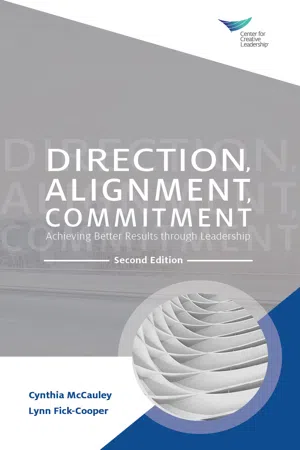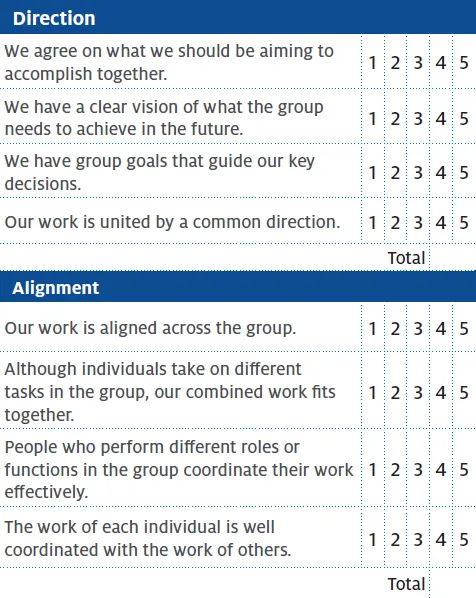
eBook - ePub
Direction, Alignment, Commitment: Achieving Better Results through Leadership, Second Edition
- 64 pages
- English
- ePUB (mobile friendly)
- Available on iOS & Android
eBook - ePub
Direction, Alignment, Commitment: Achieving Better Results through Leadership, Second Edition
About this book
This book will show you how to diagnose problems in your team by focusing on the three outcomes of effective leadership: direction, alignment, and commitment. By assessing where your group stands in each of these outcomes, you can plan and implement the changes necessary to get better results.
Frequently asked questions
Yes, you can cancel anytime from the Subscription tab in your account settings on the Perlego website. Your subscription will stay active until the end of your current billing period. Learn how to cancel your subscription.
No, books cannot be downloaded as external files, such as PDFs, for use outside of Perlego. However, you can download books within the Perlego app for offline reading on mobile or tablet. Learn more here.
Perlego offers two plans: Essential and Complete
- Essential is ideal for learners and professionals who enjoy exploring a wide range of subjects. Access the Essential Library with 800,000+ trusted titles and best-sellers across business, personal growth, and the humanities. Includes unlimited reading time and Standard Read Aloud voice.
- Complete: Perfect for advanced learners and researchers needing full, unrestricted access. Unlock 1.4M+ books across hundreds of subjects, including academic and specialized titles. The Complete Plan also includes advanced features like Premium Read Aloud and Research Assistant.
We are an online textbook subscription service, where you can get access to an entire online library for less than the price of a single book per month. With over 1 million books across 1000+ topics, we’ve got you covered! Learn more here.
Look out for the read-aloud symbol on your next book to see if you can listen to it. The read-aloud tool reads text aloud for you, highlighting the text as it is being read. You can pause it, speed it up and slow it down. Learn more here.
Yes! You can use the Perlego app on both iOS or Android devices to read anytime, anywhere — even offline. Perfect for commutes or when you’re on the go.
Please note we cannot support devices running on iOS 13 and Android 7 or earlier. Learn more about using the app.
Please note we cannot support devices running on iOS 13 and Android 7 or earlier. Learn more about using the app.
Yes, you can access Direction, Alignment, Commitment: Achieving Better Results through Leadership, Second Edition by Cynthia McCauley,Lynn Fick-Cooper in PDF and/or ePUB format, as well as other popular books in Business & Business Education. We have over one million books available in our catalogue for you to explore.
Information
STEP 1
Assess Current Levels of Direction, Alignment, and Commitment in the Group
Let’s start by examining three groups struggling with DAC outcomes.
01
Case 1: The board of a state-focused foundation whose mission is to improve the health of its systemically oppressed and often under-resourced residents is creating a new five-year strategic plan. As the board evaluates the impact of the foundation’s grants over the last five years, several board members express concerns that the foundation might be headed in the wrong direction. While some of the individual programs the foundation funds have resulted in impressive successes (e.g. local clinics providing much needed health care services to a greater number of under-served rural residents), the board hasn’t seen enough improvement on overall health indicators for those residents who do not experience privilege or social advantages (e.g. reduction in childhood obesity rates or increases in high school graduation rates). Every board member supports the foundation’s mission, and while the board feels good about what the foundation has achieved across the state with many of their individual investments, they wonder why the results don’t reflect greater overall impact. Does the foundation’s overall direction need to change radically to get the results they hope for? Some members seem eager to embrace a new direction; others are feeling the need to be more cautious.
02
Case 2: Gabriela is serving as the Human Resources representative on a cross-functional team designing and implementing an onboarding process for all new employees of a large bank that requires consistent, high-quality processes across all departments and branches or locations. Having seen some inconsistencies with several locations, the leadership of the bank has put together a team with representatives from all departments to ensure an accurate, consistent, and comprehensive training program for new employees. Team members know what they are trying to achieve, and they work together to craft a team charter that everyone supports. They’ve put in place a plan to accomplish the work and have assigned specific tasks to each team member. However, the team is falling behind on its timelines and Gabriela is worried. Sometimes the team seems unclear about who is responsible for what, and they have to repeatedly revisit and clarify assignments. She also has noticed that the team gets bogged down when trying to reconcile different ideas about how best to design some aspects of the overall process. She doesn’t think the team has a direction problem, but are they struggling with aligning their work?
03
Case 3: Deon is the project manager for a new product development team responsible for developing the next big innovation in a consumer electronics organization’s most important line of business. The team has extensive market research into customer needs, representatives from critical organization departments, and a substantial budget for prototyping and testing. Unfortunately, the team is experiencing extensive quality issues with the first prototype they sent to market testing. At each of their last three team meetings, at least one or two members were absent due to schedule conflicts or competing deadlines. Since not all of the team members report directly to Deon, he is struggling with how to get the group to commit the time and effort required to address the quality issues so that the team can achieve its goals.
When you find yourself in similar situations, concerned about whether individuals are pulling together in ways needed to succeed as a group, it is time to step back and assess the degree to which the group has the DAC it needs to achieve success. Use the statements in the “DAC Assessment” below to complete a systematic assessment of DAC in the group. Better yet, have everyone in the group rate each of the statements and combine answers. Getting this broader input from group members is particularly important if you are the formal leader of the group, as your position in the group can skew your perspective. For instance, you may be less likely to sense a direction problem because you had a hand in setting the direction.
DAC Assessment
Instructions: On a scale of 1–5, indicate the extent to which each of the following statements describes the way things are currently in the group. The terms we, our, everyone, and people in the statements refer to members of the group. Once you have rated the individual statements, add up your ratings in each section to yield total scores for direction, alignment, and commitment.
An online version of this assessment is available at www.ccl.org/dac2ed.



Before using the DAC Assessment with a group, be sure to clarify what group you are asking individuals to rate, as people could be members of multiple groups. Also, some groups may be a part of larger units in the organization. For example, are you asking for ratings of the accounting office or of the larger finance group? And people are often members of multiple temporary project teams. To eliminate potential confusion, we recommend that you replace the word “group” in the assessment instructions with the actual name of the group that you want individuals to rate.
There are a number of ways to gather DAC assessment data anonymously from group members (which encourages honest responses) and combine their data into a group-level summary for the entire group to review.
Here are some suggestions:
• Distribute paper copies of the assessment and have group members return it to a central person who tallies the data for the group.
• Create an online survey and send the link to group members. The survey package typically will produce a group summary of the data.
• Ask group members to complete the online assessment at www.ccl.org/dac2ed and bring the printed results to a group meeting. The assessment sheets can be gathered, shuffled, and randomly redistributed. Individuals can then transfer the data from the sheet they received to a wall chart that allows the group to see the whole group’s data.
Whichever process you use, make sure individuals are given clear instructions about which group they are being asked to rate.
The goal of this assessment step is to identify whether any or all of the three key leadership outcomes is low in the group. Some criteria for deciding if an outcome is low include:
• a total score for an outcome is noticeably lower than the total score for the other outcomes
• a total score for an outcome is less than 16
• two to three of the statements used to assess an outcome are rated less than four by a majority of group members
If the group identifies one or more low outcomes, you should begin exploring what factors may be contributing to these outcomes.
If you don’t have time for everyone to do the assessment, here’s an alternative for getting a quick read on DAC in the group. Provide the DAC diagram below with the short description of each outcome and have group members engage in a dot-voting exercise. Supply each group member with two...
Table of contents
- Cover
- Title Page
- Copyright
- Contents
- Do You Have a Leadership Problem?
- DAC Leadership Framework
- Step 1: Assess Current Levels of Direction, Alignment, and Commitment in the Group
- Step 2: Look for Factors Contributing to Low Levels of Direction, Alignment, or Commitment
- Step 3: Identify Changes That Could Improve Direction, Alignment, or Commitment
- The Rest of the Story
- Suggested Resources
- Background